Aerospace engineering alumni are part of successful NASA test flight mission
NASA began a new era of exploration with the Orion test flight on December 5, 2014. The Exploration Flight Test (EFT-1) was a two-orbit and nearly five-hour mission to test critical Orion systems, including the avionics, parachute and heatshield.
This program would not be possible without the work of several recent Cyclone Engineers:
- Molly White, aerospace engineering, 2009
- Kelly Smith, aerospace engineering, 2010
- Kara Pohlkamp, public relations and aerospace engineering, 2005
- Jon Pohlkamp, aerospace engineering, 2005
- David Lantz, aerospace engineering and materials engineering, 2008
- Sara McNamara, aerospace engineering, 2008
- Luke McNamara, aerospace engineering, 2008
- Jeffrey Gutkowski, aerospace engineering, 2007
- Mark Kane, aerospace engineering, 2009
- David Shoemaker, mechanical engineering, 2004
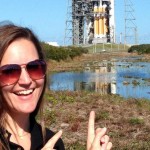
Molly White, heatshield engineer
Aerospace engineering, 2009
White works on the heatshield team, which is critical for a safe send-off and return for the astronauts coming home from any deep space destination. White has been studying airflow prediction around the vehicle to understand the heat the heatshield must withstand. The heatshield is the exterior surface of the vehicle designed to withstand the extreme temperatures during re-entry. It purposely decomposes to carry away energy from the vehicle. For Orion’s first flight test, it is predicted that 20% of the heatshield was burned.
White’s journey to NASA started as a co-op and she became a full-time employee in February 2010. She had been told she would work on the Constellation program, which was cancelled on her first day. White has worked on Orion ever since. She is looking forward to using this critical flight test data to refine the heatshield design and fly Orion again in 2018.
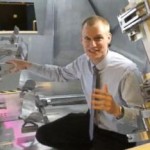
Kelly Smith, guidance and navigation engineer
Aerospace engineering, 2010
Smith originally came to NASA on a co-op during his time at Iowa State, where he worked with Johnson Space Center to redevelop the Apollo lunar orbit determination software, develop a real-time Space Shuttle tracker and perform launch availability analysis for a lunar orbiting space station. Since this experience, Smith has worked on the Orion team as a guidance and navigation engineer and on the Orion Flight Control Team.
Smith’s work at NASA focuses on Orion’s onboard navigation and entry guidance. He also served as the trajectory officer for the test flight on December 5, 2014, “It was my job to monitor the trajectory, respond to anomalies, and predict the entry trajectory and splashdown location.” In the future, Smith will be involved with developing flight software for the next Orion mission in 2018.

Kara Pohlkamp, guidance, navigation and control flight controller
Aerospace engineering and public relations, 2005
Like White and Smith, Kara Pohlkamp’s adventure at NASA started with as a co-op during her time at Iowa State. After graduation she became a guidance, navigation and control (GNC) officer in mission control, where she worked 17 shuttle flights.
As a lead for Orion GNC operations development, she worked to integrate GNC failure response plans and monitored Orion’s navigation hardware, software and vehicle control during flight.
Kara Pohlkamp still works with Iowa State, serving on the advisory council for the department of aerospace engineering.

Jon Pohlkamp, command and handling flight controller
Aerospace engineering, 2005
Kara and Jon Pohlkamp met at Iowa State and now work together at NASA. Also a former Shuttle flight controller, Jon Pohlkamp served as the EFT-1 command and data handling (CDH) officer in mission control, where he monitored the Orion’s computer and data networks. As the CDH operations lead, he worked pre-flight to coordinate failure contingency plans.
Jon Pohlkamp will be working with the development of Orion in future missions. He looks forward to figuring out how to operate the developing spacecraft to contribute to the flexibility and safety of the design.
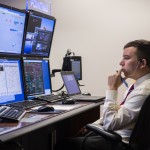
David Lantz, attitude and pointing flight controller
Materials engineering, aerospace engineering, 2008
Lantz also began his adventure at NASA with a co-op in 2005. After graduating in 2008, he began working full-time for the organization. While working on Orion, Lantz, who graduated in 2008, served as backup lead attitude and pointing flight controller for the recent Orion test flight. “This included providing line of sight data and coverage for the Tracking and Data Relay Satellite System preflight and supporting pre-flight console operations.” The data Lantz collected was used during NASA’s time scheduling process and to avoid outages during the flight.
In the future, Lantz will continue working with the Orion mission in the attitude design and optimization areas.

Luke McNamara, flight dynamics and guidance, navigation and control design engineer
Aerospace engineering, 2008
While studying at Iowa State, Luke McNamara was employed at NASA during a co-op with the Johnson Space Center. After graduating, Luke McNamara began working on Orion in the flight dynamics and guidance, navigation and control (GN&C) team to design the entry trajectory. He also studied Orion’s guidance, navigation and control system and the integrated Orion spacecraft for EFT-1 and future missions.
In the future, Luke McNamara will continue supporting the development of the GN&C system and trajectory design for the next Orion mission in 2018.
Sara (Blatz) McNamara, flight dynamics/guidance and control design engineer
Aerospace engineering, 2008
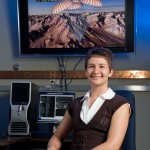
Sara McNamara’s adventure at NASA also began with a co-op at the Johnson Space Center, where she characterized the aerodynamics of the Orion spacecraft. After graduating, Sara McNamara continued working with Orion on the flight dynamics team to design guidance and control algorithms for Orion’s launch abort vehicle.
She will continue working with the launch abort system in the future, focusing on guidance and control design.
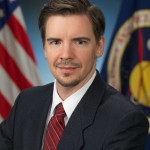
Jeffrey Gutkowski, trajectory and mission design engineer
Aerospace engineering, 2007
Gutkowski began alternating semesters between Iowa State and NASA’s Johnson Space Center in 2004. Since that time, he has worked in the Orion program as a mission designer. When designing EFT-1, he helped craft the mission concept and reference trajectories for EFT-1. Subsystems of the Orion spacecraft use the reference trajectories to design and build the Orion spacecraft.
Gutkowski is currently developing trajectories for Orion’s future missions, which will eventually take humans farther than ever before. These trajectories account for propellant needed for missions, but also safely returning astronauts during emergency situations.
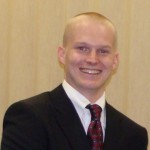
Mark Kane, aerospace engineer
Aerospace engineering, 2009
Like many others at NASA, Kane worked on several co-ops during his time at Iowa State. He served in several different areas, including structures and the integrated guidance, navigation and control branches. Kane now works on Orion’s touchdown to prevent structural failure at touchdown by orienting the vehicle with the direction of travel. His work has focused on designing and testing touchdown guidance and control.
In the future, Kane will continue designing and analyzing touchdown control. He will also continue developing flight software in the entry mode and entry flight control groups.